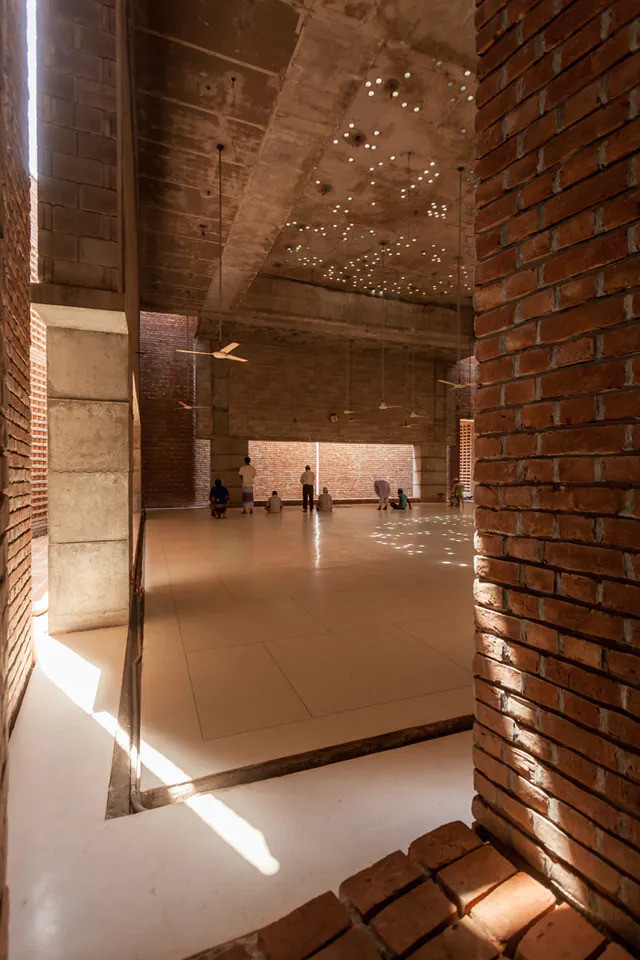
The mosque is a perfect square that sits on a high plinth, which prevents
floodwater from entering the structure, allows people to sit and talk, and
creates a separation between the sacred site and the busy street.
An adherence to the essential –
both in the definition of the space and the means of construction – was
crucial in formulating the design of Bait ur Rouf Mosque. With land donated by
her grandmother and modest funds raised by the local community, the architect
has created an elemental place for meditation and prayer.
The irregularly shaped site is
covered by a high plinth, which not only protects against flooding but provides
a gathering place set apart from the crowded street below. On top of the
plinth sits the mosque, a perfect square, 23m x 23m, and 7.6m high. Within this
square is a cylinder, displaced to the northwest corner of the perimeter wall
to create additional depth for the colonnade and the ablution area on the
south- and east-facing sides respectively. And within this cylinder is in
turn a smaller square, 16.75m x 16.75m and 10.6m high that is, 3m taller
than the perimeter wall. Rotated within the cylinder to orientate itself with
the qibla, this pavilion contains the prayer hall, which is separated from the
rest of the building by open-to-sky lightwells.
There are two structural systems
in place – the load-bearing brick walls that define the outer perimeter and the
smaller spaces, and the reinforced-concrete frame that spans the column-free
prayer hall. The brick walls exploit the depth between the outer square and the
inner cylinder, allowing for buttressing in the interstitial space. This
in turn makes it possible for panels between the load-bearing structure
to have a jali of brick, leaving out alternate bricks and rotating them.
In the prayer hall itself, a simple vertical gap in the brick denotes the
direction of the qibla, but the recess is splayed so that worshippers are not
distracted by sight lines onto the busy street. What they see instead is
sunlight bouncing off the wall behind. Awash with light, open to the elements,
the mosque ‘breathes’.
Features:
-The quality of space and architecture in this project proves
that with the use of local materials and dedicated craftsmen, and an attempt
towards spirituality through light can span the distance between here and
infinity, between today and eternity.
-The monsoon rain may pose a problem as the openings for the
hot air to escape also allow in rain. However, it is important to keep
cross-ventilation even when it is raining, and the rain seems to have good
drainage in the spaces where it enters. Also,
-Column-free prayer hall is raised on eight peripheral
columns, in addition to four light courts, random circular roof openings allow
daylight into the prayer hall creating an ornate pattern on the floor enhancing
spirituality through light.
-Qibla direction is marked by a slit of light penetrating the
cylendrical brick wall which forms a light court with the facing flat wall.
-Corner Lightcourt and the vertival linear gap that indicates the qibla direction.
-Interior view showing the minimum materials used, exposed
concrete and bricks, where light and ventilation are naturally provided by the
simple vocabulary of Jali bricks architecture.
-The prayer hall is a carefully scaled and proportioned
volume that is contemplative in nature, is evenly lit to enhance the feeling of
all as equal.
-The riwaq, or colonnade use the
additional depth allocated by the cylinder off-centred on the south facing
side.
-Terracotta bricks used for the
structure are left exposed internally and externally. They lend the building a
character that references the architecture of nearby buildings, as well as
religious architecture of the past.
I agree to the terms outlined below:
You agree to upload and assign Mosqpedia Database the rights to use the content worldwide and in perpetuity across all current and future media platforms. Mosqpedia Database may edit, copy, adapt and translate your contribution.
The content will be distributed under the Creative Commons Attribution-Deed – Attribution-NonCommercial-NoDerivatives 4.0 International – Creative Commons
All data will be stored in line with data protection regulations.
I agree to the terms outlined below:
You agree to upload and assign Mosqpedia Database the rights to use the content worldwide and in perpetuity across all current and future media platforms. Mosqpedia Database may edit, copy, adapt and translate your contribution.
The content will be distributed under the Creative Commons Attribution-Deed – Attribution-NonCommercial-NoDerivatives 4.0 International – Creative Commons
All data will be stored in line with data protection regulations.